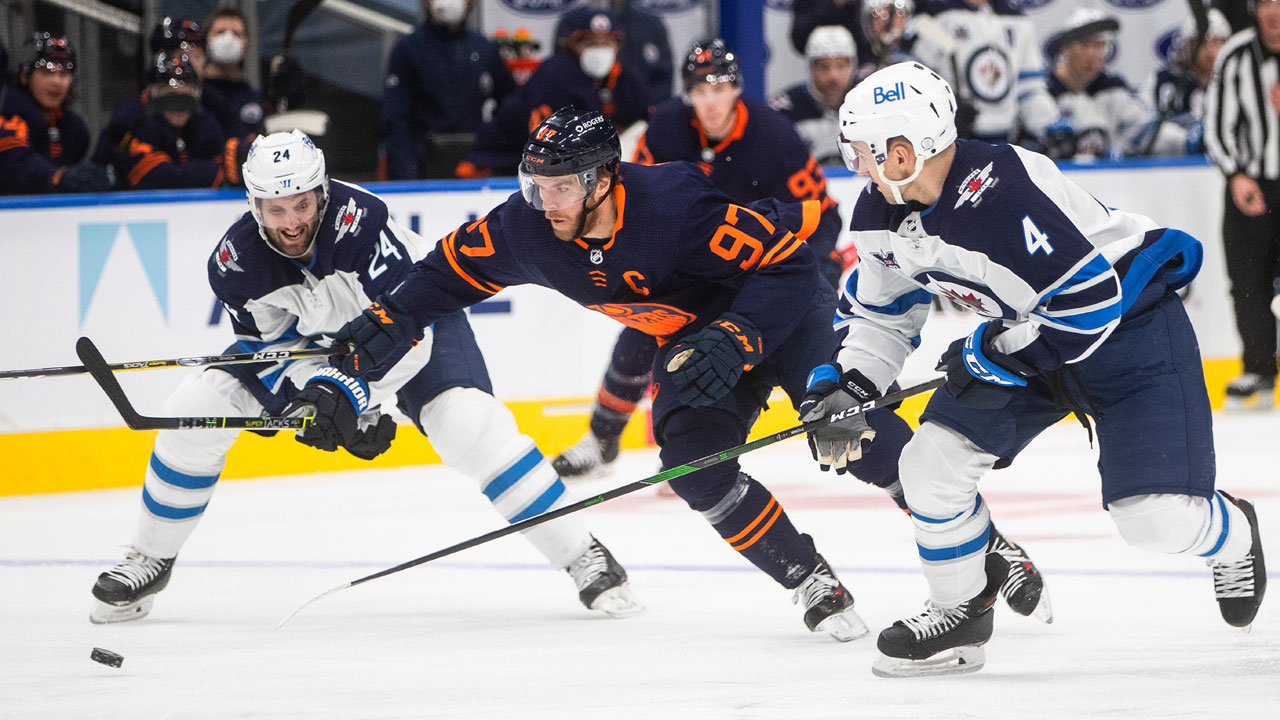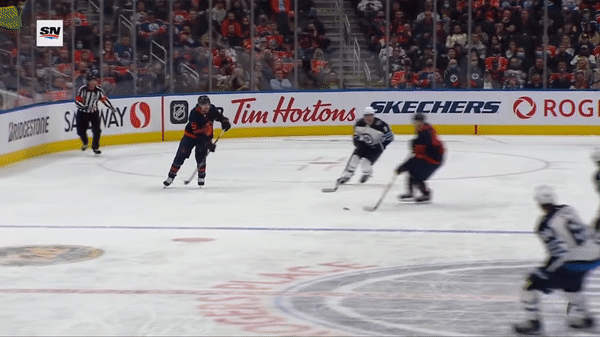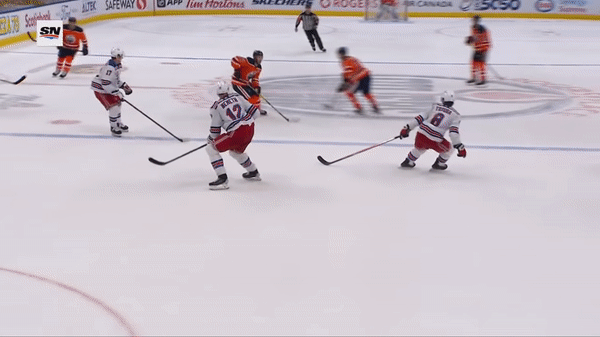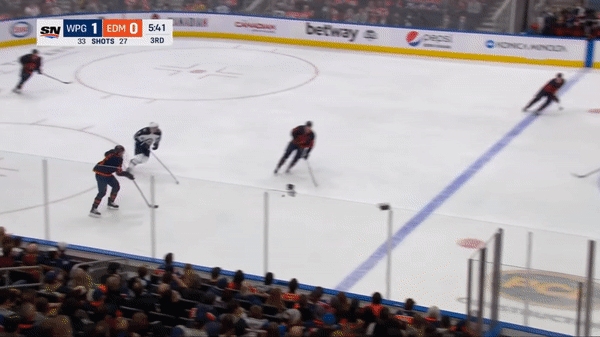
Amid a career that’s already been stuffed with trophies, records and plenty of highlight-reel fodder, there are times, even still, when Connor McDavid makes you just stop and watch.
A two-week stretch in November was the latest to drop jaws. First came a night against New York that saw the Edmonton Oilers captain dart through four Rangers, picking his way through the crowd with a casual ease, before slipping the puck past Alexandar Georgiev to tie the game in its final minutes (his Oilers went on to win in overtime). Thirteen days later, he did it again, this time flying past a pack of unlucky Winnipeg Jets before whipping the puck past Connor Hellebuyck’s blocker, tying that game with five-and-a-half minutes remaining (his Oilers went on to win in a shootout).
There are certain moments, watching No. 97, where the gap between his skill-set and the rest of the league seems exaggerated to a comical degree. Where the unexplainable discrepancy between what he’s capable of and what those around him are capable of reveals itself in brilliant, embarrassing fashion.
Sportsnet analyst and former pro Justin Bourne offered his insight into what exactly lies in that gap between McDavid and his opponents during a new Hockey Central segment called ‘Posterized.’
“What Connor McDavid does that’s so unbelievable, that isn’t a part of the NHL game right now, is change direction,” Bourne said. “The way he cuts laterally is not something you see in our sport. It’s a sport that has glide and direction — I mean, that cut at the centre-red, the very first cut to get to the middle of the ice, which is where he’s so dangerous, that cut right there is something you don’t see in the NHL at that pace.”
It’s not just that McDavid moves in a way we’ve rarely seen in the game before. It’s that his advanced skating ability seems to allow him to pull in patterns of movement that we see from greats in other sports, layering those in on top of his well-established ability to dominate his own.
“It reminds me of The Professor at the AND1 Mixtape Tour. This is the thing that he’s doing, he’s blowing up guys’ ankles in our sport,” Bourne continued. “Barry Sanders is a great example from the NFL, where you see guys think they’ve got him all sized up, but even when guys get a hand on Sanders, he’s strong enough, just like McDavid is. But the thing is, so few guys get a hand on them because of the way they cut.”
That idea of McDavid’s movement being reminiscent of Sanders or The Professor stuck with me. So I showed clips of No. 97’s goals against the Rangers and Jets to a few coaches who work in the basketball and football worlds to get their take on how the Oilers captain’s skill-set overlaps with what they see from the best in their own sports. Here’s how they saw it.
Justin Alliman, a basketball development coach who’s worked with Team Canada and WNBA star Kia Nurse, as well as the Raptors 905 — and who, incidentally, grew up playing hockey — said there’s more similarity in movement between hockey and hoops than some might think, and McDavid certainly lives in that overlap.
“Basketball, it’s a lot of stop-and-go motion. So, you not only have to be quick, but you also have to know how to use your angles to your benefit. And usually the best players in the game are great at changing speeds and changing direction,” Alliman explained. “When I was watching Connor McDavid, I would think that the really exceptional thing about him is his skating ability. He’s unbelievable at deceiving with the puck, and I relate that a lot to the crossover in basketball, which allows him to be able to weave in and out of defenders.”
Both sports rely on explosive speed, he continued, a strong push-off that creates separation before momentum carries you down the court or the ice. In the former, being able to combine that explosive speed with an ability to stop, shift, and change direction separates the great from the good. There’s no question McDavid’s ability to tap into that world of movement gives him a dangerous step up against opponents who can’t match him.
“It’s going to give him a clear advantage if he’s able to stop and go, or change his angles a lot quicker than the rest of those defenders. While their bodies are trying to formulate what the heck is going on, he’s already changed direction. Not once, not twice, but sometimes three times in those clips I saw,” he said. “Before they’re even able to recover on the first move, he’s done.”
And then there’s the matter of how McDavid brings the other aspects of his skill-set into the mix. Alliman drew a comparison between the Oilers centreman’s handles and those of Brooklyn Nets point guard Kyrie Irving.
“In basketball, just like hockey, your foot speed has to match with your hand speed,” Alliman said. “I think that Connor’s puck-handling is very quick and sharp, but it’s also relaxed at the same time. That’s what makes him so deceiving and very effective at what he does.”
That changing of angles, that ability to stop and go, brings to mind the greats on the court. But the rapid decision-making at full speed, in traffic, that calls to mind the football world. I asked Ozzie Blackett, the running backs coach for the University of Toronto’s football team, to watch those same McDavid goals and give his take. He too saw the overlap with how McDavid moves and how the best in his own sport do it.
“One of the things that makes it related to a running back in football is the downhill attack,” Blackett said. “For running backs, especially our young guys, you try to relay to them the importance of just attacking and running to the end zone. And basically, that’s how McDavid is working on his opponent — his hips are guided to the goal.”

Navigating the path taken during that steamroll to the end zone, or the net, all comes down to elite footwork and balance.
“It’s the equivalent of a running back, basically, what we call ‘cutting,’” Blackett said of McDavid’s goals. “You’re cutting off your right foot, cut off your left foot, cut off your right foot and with your elite quickness, you’re able to manipulate the defenders without turning your hips. Your feet are the weapon that’s deceiving everyone.
“As a running back, being able to run inbounds, to evenly cut off either leg or either foot, right or left with the same emphasis and without wasting motion, that’s what you call ‘downhill running.’”
A closer look at what exactly McDavid is doing on those two goals, particularly in terms of his footwork, makes clear how similar the approach is. Pavel Barber, a stickhandling coach who’s worked with a number of NHL and youth players, teaching them the finer details of high-level sequences like these, broke it down for us.
“He has his feet wide in a glide, then quickly steps in with the right foot to the outside edge. With his weight on the balls of his feet, he gets a strong push from the inside edge of the left foot, then a strong secondary push from the outside edge of the right foot,” Barber said of the play against the Rangers. “On the goal versus the Jets, we see similar patterns. … He hits one crossover to gain the middle, then another crossover to change the angle and keep the speed going. The defenders have to respect him going wide, and that second crossover allows him to attack with speed.
“The fact is, what is considered an option to attack for McDavid is simply not for most players. He sees the smallest areas with three or four opponents nearby, and knows he can make something happen. It’s so intimidating for the opponents because you almost don’t prepare for that. But you can see his eyes scanning the whole way, seeing a small course he thinks he can get through, and he commits.”
That mention of preparation is key to understanding just how big of an advantage this is for McDavid. Aside from the fact that his skating ability allows him to do things on the ice that we’ve rarely seen before, an essential part of the equation is the fact that he’s doing them against defenders who’ve likely never faced anyone who moves like him. Defenders who are forced to process in real time what they’re seeing and how they can possibly slow it down.
Blackett’s seen that unpredictability before on the field, in one of the current greats.
“You’re able to recruit information from history, but McDavid is elite, so they don’t really have an opportunity to rehearse with someone else. In football, I’ll go a little bit out of the box right now and I’ll say Lamar Jackson. Quarterback, not a running back, but has elite running ability,” Blackett said.
At some point in Jackson’s early career, before he became a household name, there would’ve been a point when his opponents lined up across from him and expected one series of possibilities, only to be met with an entirely different reality, Blackett explained. They would’ve had to try to figure out, in the moment, how to handle a skill-set entirely different from the one they’d prepared for.
“You haven’t experienced it before, so now it just overwhelms you.”

So, what is it exactly that allows McDavid to do any of this? To move in ways that have those in other sports seeing shades of their own? Part of it is speed, no doubt, but as Alliman says, also key is an understanding of how to exploit angles and changes of direction. As Blackett says, it’s also about balance, footwork, and economy of movement. Barber notes too that none of it would work if McDavid couldn’t handle the puck as well as he does while doing all of that.
Matt Nichol’s seen the intricacies of McDavid’s skill-set up close, having worked with him in the past alongside a number of other elite, all-world NHLers. In his view, it’s all those aspects working in tandem that makes the Oilers pivot such a force.
“With Connor, he certainly has speed, there’s no question about that. He’s got speed. But I would suggest that, you know, in a straight line or a lap of the ice, there probably are a number of players that are of a comparable ability with regards to speed,” Nichol said. “I think it’s more so his ability to think fast and move his hands fast and to keep his head up and have a wide field of vision while he’s moving fast and to be able to move laterally and change direction, but do that while you’re controlling the puck and do that while you’re making decisions at a rapid speed. That’s the magic.
“I have worked with hockey players that were as fast, you know, in the middle of the summer or at training camp, in a straight line with no puck, and no decisions that need to be made. There are, there have been and there will be athletes that can skate as fast. So, it is speed, there’s no question — but it’s not just speed.”
It’s that quick decision-making that truly separates McDavid from the pack. The Oilers captain’s reaction time has long been seen as one of his truly remarkable attributes. There’s one particular drill Nichol and Co. ran at the annual BioSteel camps that put that otherworldly reaction time on display.
“It’s a 20-yard sprint, but at the 10-yard mark, the athlete is cued to diverge from the path slightly left or slightly right by a light that’ll cue them, and they have no idea if it’ll be left or if it will be right, or when exactly they’ll get that cue,” he explained. “Connor’s extremely fast, but he wasn’t one of the fastest guys there. You know, he wasn’t in the top five, when there wasn’t the element of reaction and decision-making.
“But as soon as you added the component of a reactive, high-speed decision, all of a sudden he went right to the top of the charts.”

Nichol has a lengthy history training NFL and CFL players alongside his work in the hockey world, his Hamilton Ti-Cats — for whom he serves as director of player health and performance — losing in OT in the Grey Cup Final last weekend. The overlap between what separates McDavid and what allows players in the football world to thrive is directly related to that rapid decision-making ability, he explained.
“I think that it’s very similar to a running back or a wide receiver in football — there are lots of track and field athletes that might be faster in a straight line, when you know that you have to wait in your stance until the gun goes off, [and]when the gun goes off, you run as fast as you can in the boundaries of the lane that you’ve been assigned, until you cross the far line. That’s a very different ability,” Nichol said. “It’s not any more or less, it’s just different than someone that doesn’t know when the gun is going to go off, doesn’t know which lane they have to run in, and while you’re running the race, the lane might change and you may have to move left or move right.
“It’s a different ability. It’s a different skill-set. And in that capacity, Connor excels.”
That brings us back to the name of the segment that kicked this all off — ‘Posterized.’ So named for the fact that, seven seasons into his big-league career, McDavid’s unique blend of abilities has him utterly dominating opponents in a way we’ve rarely seen in the game.
For those who aren’t familiar with the term ‘posterized,’ it essentially refers to a dunk so spectacular that the image is bound to end up on a poster — a testament to how impressive the dunker is, and a tough result for the player on the receiving end.
But it’s more than just a run-of-the-mill highlight. It’s a moment that stands apart, that shocks and awes. That makes you stop and watch.
“Many guys in the NBA dunk, but not everybody posterizes people,” Alliman explained. “That’s more of an instance where somebody is caught off-guard by how quick or explosive a player has been. You use things that are uncanny, that other players rarely have, like the burst of speed, the power and the grace.”
Watch those two goals again, watch McDavid fly through the mass of sticks and jerseys and emerge on the other side, bodies behind him twisting and falling awkwardly to the ice, and that term seems to aptly sum up the ridiculous displays we’re now seeing from No. 97. Alliman agrees.
“With his plays, you could say they’re pretty posterizing, in hockey form,” he said. “He just comes on so aggressively, so quickly and before you know it, the goalie is overwhelmed. He’s right in front of you. And the puck is in the net.”




